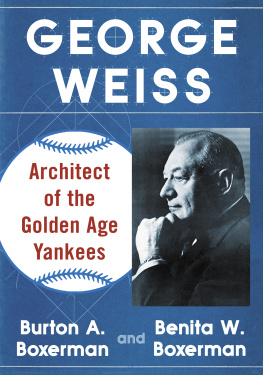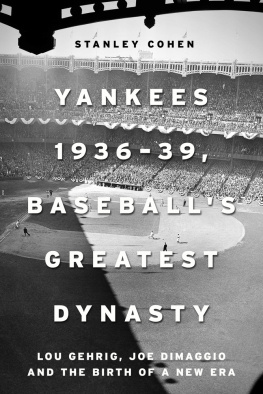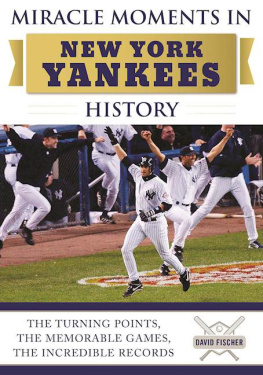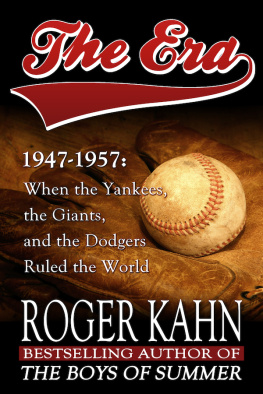
Also by BURTON A. BOXERMAN
AND BENITA W. BOXERMAN
AND FROM MCFARLAND
Jews and Baseball: Volume 1, Entering the American Mainstream, 18711948 (2007; softcover 2016)
Jews and Baseball: Volume 2, The Post-Greenberg Years, 19492008 (2010; softcover 2016)
Ebbets to Veeck to Busch: Eight Owners Who Shaped Baseball (2003)
GEORGE WEISS
Architect of the Golden Age Yankees
Burton A. Boxerman and
Benita W. Boxerman

McFarland & Company, Inc., Publishers
Jefferson, North Carolina
LIBRARY OF CONGRESS CATALOGUING DATA ARE AVAILABLE
BRITISH LIBRARY CATALOGUING DATA ARE AVAILABLE
e-ISBN: 978-1-4766-2489-1
2016 Burton A. Boxerman and Benita W. Boxerman. All rights reserved
No part of this book may be reproduced or transmitted in any form or by any means, electronic or mechanical, including photocopying or recording, or by any information storage and retrieval system, without permission in writing from the publisher.
Front cover: George Weiss in an undated photograph (National Baseball Hall of Fame Library, Cooperstown, N.Y.)
McFarland & Company, Inc., Publishers
Box 611, Jefferson, North Carolina 28640
www.mcfarlandpub.com
Acknowledgments
We are grateful to many people who provided time, knowledge, and materials as we researched, wrote, and acquired pictures for this book. Many are referenced in the notes and bibliography, but we want to give special recognition to the following:
Our many friends, associates, and family who always seemed genuinely interested in the writing and contents of the book, and patiently allowed us to bore them with tales of progress when they asked, Hows the book on George Weiss coming along?
Many members of SABR who not only followed the progress of the book but were willing and able to supply tidbits of information that helped make the book both more accurate and interesting.
Librarians and archivists at the St. Louis County Library, New Haven Public Library, New Haven Historical Society, Hillhouse High School and Yale University who provided us with material on George Weiss and obtained books for us through interlibrary loan.
For help in obtaining photographs for the book we are extremely grateful to Steve Steinberg; Dwayne Labakas; Maxwell Kates; Ken Roussey, National Baseball Hall of Fame Library; Charles Brown, St. Louis Mercantile Library at the University of MissouriSt. Louis; Jack Paulishen, James Hillhouse High School in New Haven; and Dave Kaplan, Yogi Berra Museum and Learning Center.
All of these individuals aided us along the way, and the book is better because of their generosity. For any errors that remain, however, we take responsibility.
Preface
The New York Yankees were the most successful franchise in major league baseball from the 1920s through 1964. One of their most impressive periods was the 12 seasons from 1949 to 1960, when the team captured the American League pennant ten times and became World Champions seven times. They were so good that there were constant demands from other team owners, sports writers, and fans to break up the Yankees and give the other AL clubs a chance. The seemingly indestructible Yankees even inspired a novel, The Year the Yankees Lost the Pennant, by Douglass Wallop, which was converted into the smash Broadway musical Damn Yankees.
Ask the average baseball fan what made those Yankees so dominant and most will come up with names such as Joe DiMaggio, Yogi Berra, Whitey Ford, Mickey Mantle, Ed Lopat, Hank Bauerthe list of great Yankees players during those years goes on and on. Some more knowledgeable fans might insist that those were the years when Casey Stengel was managing the team and that he was the reason the Yankees were so successful. But the sports pundits then and respected sports historians today credit as the real genius behind the team its general manager, a short, portly, often taciturn, and very shy man named George Martin Weiss.
George Weiss, a native of New Haven, Connecticut, loved baseball but he knew he did not have the ability to play the game. What he did have was the savvy to run a baseball team better than virtually anyone with whom he competed. According to his boyhood friends, George Weiss recognized this capability even before he was at New Havens Hillhouse High, where he became the student manager of the schools championship baseball team.
After graduation, Weiss began his studies at Yale but was forced to leave during his first year because his father became ill and George had to run the family store. In contrast to his later character, as a young man Weiss was outgoing and able to talk convincingly with people far older than he as well as with his contemporaries. He persuaded some of the best players from his former high school team and some of the Yale players to form a semi-pro team, promising that he would set up the games and basically manage the team.
Using publicity and promotions, Weiss was so successful that his semi-pro Colonials soon outdrew the professional Class B Eastern League team in New Haven. Recognizing that they were unlikely to survive this competition, the Eastern League teams directors offered to sell the club to Weiss. Weiss borrowed the money, and in 1919, as one of the youngest owners in the game at that time, became a part of organized baseball. And as the saying goes, the rest is history. After 50-plus years in organized ball, Weiss was inducted into Baseballs Hall of Fame for contributing as much to baseball as any man the game could ever know.
Despite the fact that George Weiss has been the subject of countless magazine and newspaper stories, there is no in-depth biography of the man, his accomplishments and his contributions to both the New York Yankees and the New York Mets. We hope this book, George Weiss: Architect of the Golden Age Yankees will fill that void. We also hope that you will enjoy the book and that after reading it, you will know why he so richly deserved the many honors he received, and how he achieved his lofty standing in the game he loved so long and so deeply.
1
The Making of a Baseball Entrepreneur
One Saturday afternoon, American journalist Damon Runyon was pondering the memorable features of covering a Yale football game. After a few moments, he wrote:
New Havenwhat fond memories the name conjures
Elms
The Campus
More elms.
George Weiss.
Runyon was not exaggerating. For close to 30 years, New Haven, Connecticut, native George Martin Weiss was an integral part of the success of the New York Yankees. During his 15 years as farm club director and 13 years as general manager, the Yankees won 19 American League pennants and 15 World Series. Weiss learned his love of baseball and first exhibited his skill in directing the game not in New York, but in his tradition-rich hometown of New Haven.
George Weiss was the son of Conrad Weiss and Anna Kapitzke Weiss. His father was born in Bavaria, Germany, in the town of Nuremberg, on March 21, 1864, one of five sons of Jeorge and Mary Koppman Weiss. Until he was 17, Conrad clerked in his fathers general store, but being an ambitious youth, he felt that America offered him greater economic opportunities. He arrived in the United States in 1882 and located at Milltown, New Jersey, where he worked in a rubber factory for two years. He spent two more years doing the same kind of work in Long Island, and in 1886, left Long Island and settled in New Haven, Connecticut.
Next page







